dba
HARLEM INTERNATIONAL COMMUNITY SCHOOL
Founded 1976, Wallie Simpson, Founder and Principal
6TH Grade Science [Science 6] |
|
|--The green kingdom
|--Nonvascular Plants and Plantlike Organisms
|--Vascular Plants
|--Classification Systems
|--Viruses, Bacteria, and Protist
|--Invertebrates
|--Vertebrates
|--Scientific Measurements
|--Scientific Tools
|--States of Matter
|--Structure of Matter
|--Physical and chemical changes
|--Atoms and Molecules
|--Exploring the Universe
|--Stars and Galaxies
|--The Solar System
|--Earth and its Moon
Required Textbook: A Beka, Science 6, Work-Text, Pensacola, Florida, current edition.
[a] Motions And Forces.
[i] The motion of an object can be described by its position, direction of motion, and speed. This motion can be represented on a graph.
[ii] An object that is not being subjected to a force will continue to move at a constant speed and in a straight line.
[iii] If more than one force acts on an object, then the forces can reinforce or cancel one another, depending on their direction and magnitude.
[iv] Unbalanced forces will cause changes in the speed and/or direction of an object's motion.
[v] Magnetism is a force. Magnets are either natural or man-made. You should understand the construction of a magnet and the force it produces.
[b] Energy.
[i] Energy exists in many forms, including heat, light, chemical, nuclear, mechanical and electrical. Energy can be transformed from one form to another.
[ii] Heat energy moves in predictable ways, flowing from warmer objects to cooler ones until both objects are at the same temperature.
[iii] Light interacts with matter by transmission (including refraction), absorption, or scattering (including reflection).
[iv] To see an object, light from that object -- emitted by or scattered from it -- must enter the eye.
[v] Electrical circuits provide a means of converting electrical energy into heat, light, sound, chemical or other forms of energy.
[vi] The sun is a major source of energy for changes on the Earth's surface. The sun's energy arrives as light with a range of wavelengths, consisting mainly of visible light with significant amounts of infrared and ultraviolet radiation.
[vii] Electricity is a form of energy. Various sources of energy can be utilized in the production of electricity (Law of conservation of energy).
[viii] Understand the structure of batteries and how the changing of chemical to electrical energy is useful.
[c] Reproduction And Heredity.
[i] Reproduction is a characteristic of all living systems; since no individual organism lives forever, it is essential to the continuation of species. Some organisms reproduce asexually. Other organisms reproduce sexually.
[ii] Each organism requires a set of instructions for specifying its traits. Heredity is the passage of these instructions from one generation to another.
[iii] Hereditary information is contained in genes, located in the chromosomes of each cell. Each gene carries a single unit of information, and an inherited trait of an individual can be determined by either one or many genes. A human cell contains many thousands of different genes.
[iv] The characteristics of an organism can be described in terms of a combination of traits. Some traits are inherited and others result from interactions with the environment.
[d] Populations And Ecosystems.
[i] Populations consist of all individuals of a species that occur together at a given place. All of the populations living together and the physical factors with which they interact compose an ecosystem.
[ii] Populations of organisms can be categorized by the function they serve in an ecosystem. Plants and some micro-organisms are producers--they make their own food. All animals, including humans, are consumers, which obtain food by eating other organisms. Decomposers, primarily bacteria and fungi, are consumers that use waste materials and dead organisms for food. Food webs identify the relationships among producers, consumers, and decomposers in an ecosystem.
[iii] For ecosystems, the major source of energy is sunlight. Energy entering ecosystems as sunlight is converted by producers into stored chemical energy through photosynthesis, It then passes from organism to organism in food webs.
[iv] The number of organisms an ecosystem can support depends on the resources available and abiotic factors such as quantity of light and water, range of temperatures, and the soil composition. Given adequate biotic and abiotic resources and no disease or predators, populations, including humans, increase at very rapid (exponential) rates. Limitations of resources and other factors such as predation and climate limit the growth of populations in specific niches in the ecosystem.
[v] Photosynthesis and cellular respiration are life-sustaining plant processes. The process of photosynthesis changes sunlight into stored chemical energy by producers
[e] Structure Of The Earth
[i] The solid Earth is layered with a thin brittle crust, hot convecting mantle, and dense metallic core.
[ii] Crustal plates on the scale of continents and oceans constantly move at rates of centimeters per year in response to movements in the mantle. Major geological events, such as earthquakes, volcanoes, and mountain building, result from these plate motions.
[iii] Land forms are the result of a combination of constructive and destructive forces. Constructive forces include crustal deforamtion, volcanoes, and deposition of sediment, while destructive forces include weathering and erosion.
[iv] Changes in the solid Earth can be described as the rock cycle. Old rocks at the Earth's surface weather, forming sediments that are buried, then compacted, heated, and often recrystallized into new rock. Eventually, these new rocks may be brought to the surface by the forces that drive plate motions, and the rock cycle continues.
[v] Soil consists of weathered rocks, decomposed organic material from dead plants, animals, and bacteria. Soils are often found in layers, with each having a different chemical composition ant texture.
[f] The Solar System
[i] The Earth is the third planet from the sun in a system that includes the moon, the sun, eight other planets and their moons, and smaller objects such as asteroids and comets. The sun, an average star, is the central and largest body in the solar system.
[ii] Most objects in the solar system are in regular and predictable motion. These motions explain such phenomena as the day, the year, phases of the moon, and eclipses.
[iii] Gravity is the force that keeps planets in orbit around the sun and governs the rest of the motion in the solar system. Gravity alone holds us to the Earth's surface and explains the phenomena of the tides.
[iv] The sun is the major sources of energy for phenomena on the Earth's surface, such as growth of plants, winds, ocean currents, and the water cycle. Seasons result from variations in the amount of the sun's energy hitting the surface, due to the tilt of the Earth's rotation axis.
|
1.1 - The green kingdom
Plants are one of the major kingdoms of living things. The Plantae includes all land plants: mosses, ferns, conifers, flowering plants, and so on. Plants are important to us as they provide us with food, clothing, shelter, medicines, even the air we breathe. They also enhance the environment with their beauty and help other living creatures. Thus it is very important we are informed about plants and how we can help them thrive.
mosses, ferns, conifers, and flowering plants.

The study of plants is called botany.
|
2.1 - Classification Systems
Classification is the grouping of living things according to similar characteristics. This information is organizad into the science of classification, which is called taxonomy.
The classification process might have started thousands of years ago when people began to realize that there were different groups of living things in the world. They noticed that some animals roamed in land and looked quite different from the the ones that swam in the water or flew in the air. Some animals had sharp teeth and were very dangerous, while some, such as those that flew in the air were mostly harmless.
This painting is thousands of years old.
It shows an early attempt at classifying living things.
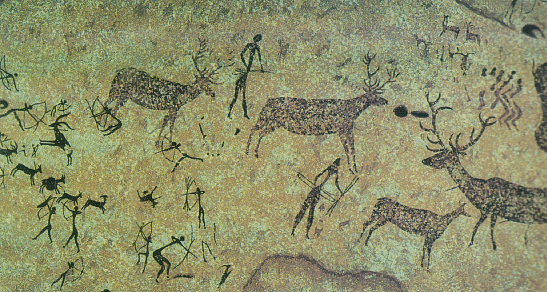
The classification process as a science might have started in the fourth century B.C. when the Greek philosopher Aristotle proposed a system that clessified the animals into three groups.
The system classified animals according to the way they moved. The system was useful but had some problems. For example, both a bird and a bat are animals that fly, yet the bat is covered with hair, not feathers.
In the seventeenth century, the English biologist John Ray set up to collect, name and classify all the plants and animals in England. Ray was the first person to scientifically use the term species: a group of organisms that are able to interbreed.
Eighteent-century Swedish scientist Carolus Linnanaeus devised a simpler naming system of binomial nomenclature. His system gave each plant and animal two names: a genus and a species,
| genus | genus | ||
|---|---|---|---|
| species | species | species | species |
Linnaeus also created higher, more inclusive classification categories. For example, he placed all monkeys and apes along with humans into the order Primates. His use of the word Primates (from the Latin primus meaning "first"), what implied that humans were created first. However, It also indicated that people are animals,
| order | |||||||
|---|---|---|---|---|---|---|---|
| family | family | ||||||
| genus | genus | genus | genus | ||||
| species | species | species | species | species | species | species | species |
The form of the Linnaean classification system remains substantially the same to this day, for example, tigers and lions belong to the genus panthera but only lions belong to the species leo.
Classification of the lion.
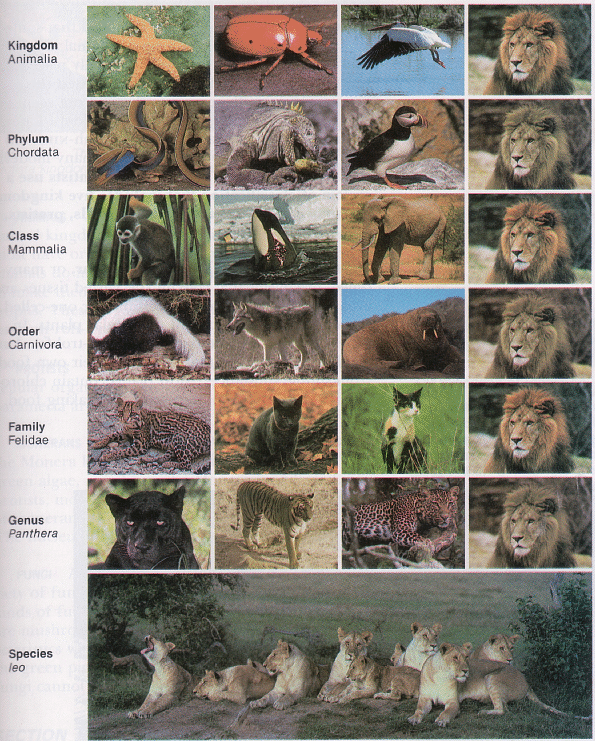
Biologists classify organisms into different categories mostly by judging degrees of apparent similarity and difference that they can see. The assumption is that the greater the degree of physical similarity, the closer the biological relationship.
On discovering an unknown organism, researchers begin their classification by looking for anatomical features that appear to have the same function as those found on other species. The next step is determining whether or not the similarities are due to an independent evolutionary development or to descent from a common ancestor. If the latter is the case, then the two species are probably closely related and should be classified into the same or near biological categories.
Homologies re anatomical features, of different organisms, that have a similar appearance or function because they were inherited from a common ancestor that also had them. For example, a whale flipper, the wing of a bat, and your arm have the same functional types of bones as did our shared reptilian ancestor. Therefore, these bones are homologous structures. The more homologies two organisms possess, the more likely it is that they have a close genetic relationship.
All mammals share similarities in their forelimb structure.
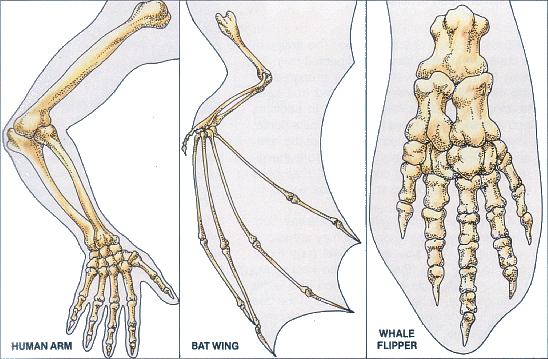
The highest category in the Linnaean system of classification is the kingdom. At this level, organisms are distinguished on the basis of cellular organization and methods of nutrition. Whether they are single- or multiple-celled and whether they absorb, ingest, or produce food are critical factors.
Most macroscopic creatures are either plants or animals,
Representative organisms of the plantae and animalia Kingdoms.
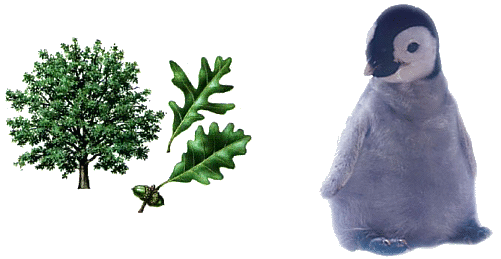
The distinction between the plant and animal kingdoms is based primarily on the sources of nutrition and the capability of locomotion or movement. Plants produce new cell matter out of inorganic material by photosynthesis. They do not have the ability to move around their environment except by growing or being transported by wind, water, or other external forces.
In contrast, animals do not produce their own food but must eat other organisms to obtain it. Animals are generally more complex structurally. Unlike plants, they have nerves and muscles that aid in rapid, controlled movement around their environment. Animal cells usually do not have rigid walls like those of plants. This accounts for the fact that your skin and flesh are flexible and the trunk of a tree is not.
This simple dichotomy between plants and animals is not adequate to encompass all life forms. Some organisms have characteristics which do not qualify them to fit neatly into either kingdom. For example, funguses and most bacteria do not photosynthesize and most of them lack a means of controlled locomotion. Some organisms have attributes of both plants and animals. For example, there is a group of common single-cell species living in fresh water ponds called Euglena that photosynthesize and have their own means of locomotion. Because of these and other exceptions, new kingdoms of living things had to be created.
The Euglena and its main parts
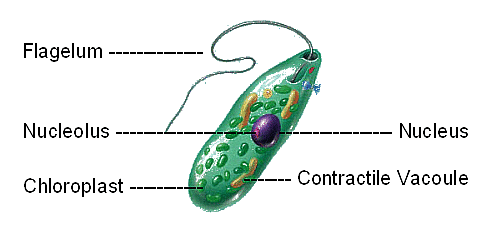
...
|
3.1 - Scientific Measurements
...
|
4.1 - States of Matter
...
|
5.1 - Exploring the Universe
...
[1] A Beka, Science 6, Work-Text, Pensacola, Florida.
[2] Focus on Earth Science: Laboratory Manual. Upper Saddle River, New Jersey: Prentice-Hall Inc., 2001.
[3] Inquiry Skills Activity Book. Upper Saddle River, New Jersey: Prentice-Hall, Inc., 2001.
[4] Project Earth Science: Physical Oceanography. Arlington, VA.: National Science Teachers Association, 1995.